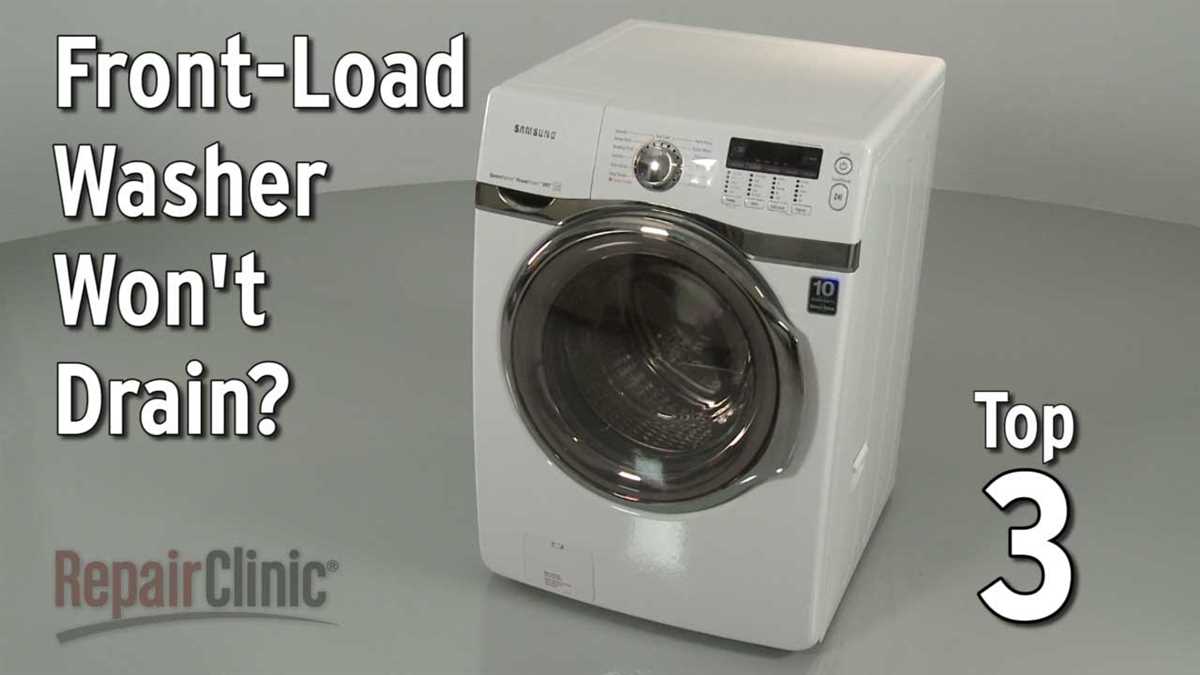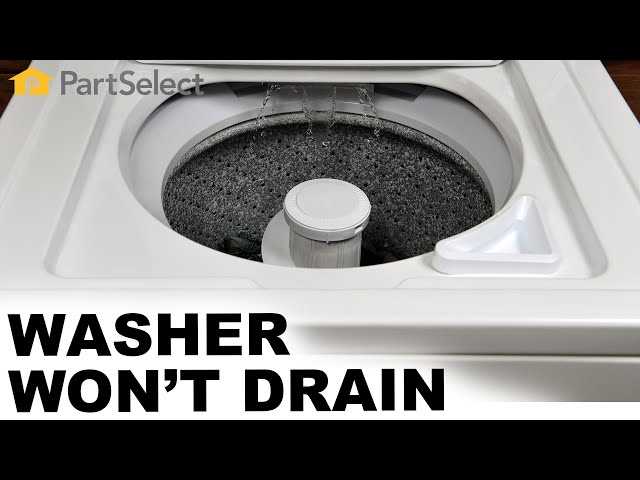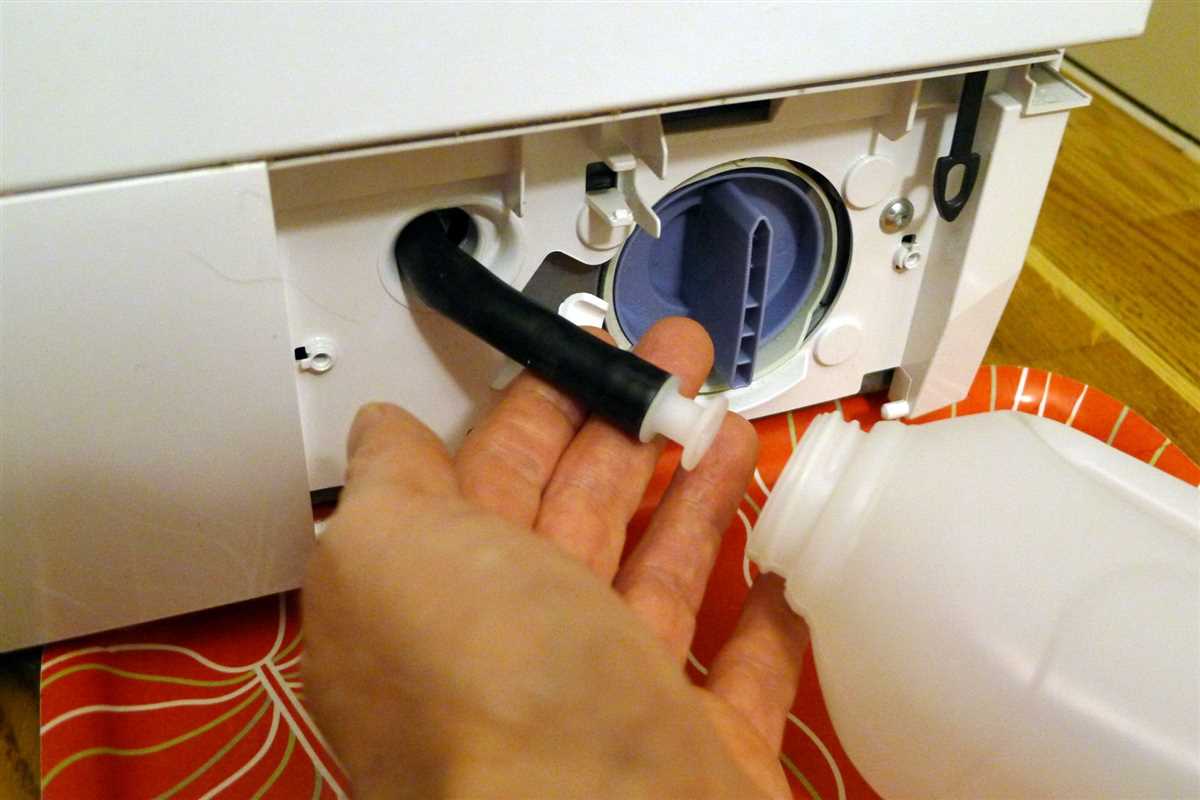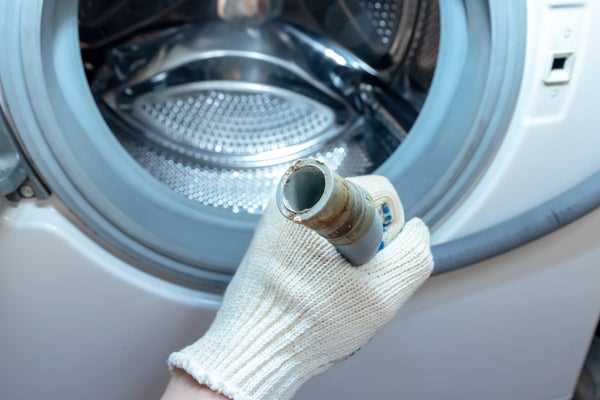




Having a washing machine that isn’t draining properly can be a frustrating experience. Not only does it leave your clothes soaking wet, but it can also cause damage to your machine if not addressed promptly. If you’re dealing with a washing machine that isn’t draining, don’t panic just yet. There are several troubleshooting steps you can take to try and fix the issue before calling in a professional.
The first thing you should do if your washing machine isn’t draining is to check for any obstructions in the drain hose. Over time, debris such as lint, coins, or even small pieces of clothing can become trapped and block the flow of water. Carefully inspect the hose for any clogs or kinks and remove any obstructions you find. If the hose appears to be clear, move on to the next step.
If the drain hose isn’t the problem, the issue may lie with the drain pump. The drain pump is responsible for pumping out the water from the machine during the drainage cycle. Sometimes, the pump can become clogged or damaged, preventing it from functioning properly. To check if the pump is the problem, you can manually try to drain the water using the emergency drain hose (if available). If the water doesn’t drain or drains very slowly, it’s likely that the drain pump needs to be replaced or repaired.
Another possible cause for a washing machine not draining is a malfunctioning lid switch. The lid switch is a safety mechanism that prevents the machine from spinning or draining when the lid is open. If the switch is faulty, it can disrupt the draining process. To test if this is the issue, manually activate the switch with a screwdriver while the machine is in the drain cycle. If the machine starts draining, it’s a clear indication that the lid switch needs to be replaced.
Common Reasons for Washing Machine Drainage Issues
When your washing machine starts to have drainage issues, it can be quite frustrating. Here are some common reasons why your washing machine may not be draining properly:
- Clogged filter or drain hose: Over time, debris such as lint, coins, or small objects can accumulate in the filter or drain hose, causing a blockage. This can prevent the water from draining properly.
- Faulty drain pump: The drain pump is responsible for pumping out the water from your washing machine. If the drain pump is faulty or broken, it may not be able to remove the water effectively.
- Drain pipe blockage: The drain pipe that leads to your home’s plumbing system can become blocked with dirt, lint, or other debris. This can restrict the flow of water and cause drainage issues.
- Improperly installed drain hose: If the drain hose is not installed correctly, it may not be able to drain the water properly. Check if the drain hose is kinked, twisted, or too high above the washer.
- Problem with the water pump: The water pump is responsible for circulating the water in your washing machine. If the water pump is not functioning properly, it may not be able to remove the water effectively, resulting in drainage issues.
In order to troubleshoot drainage issues with your washing machine, it is important to check these common causes and determine the appropriate solution. In some cases, simple maintenance tasks such as cleaning the filter or unclogging the drain hose can resolve the problem. However, if the issue persists, it may be necessary to seek the assistance of a professional technician.
Identifying the Cause of Drainage Problems
When your washing machine is not draining properly, it can be a frustrating experience. However, identifying the cause of the problem can help you troubleshoot and fix the issue. Here are some common reasons why your washing machine may not be draining:
-
Clogged drain hose: One of the most common causes of drainage problems is a clogged drain hose. Over time, lint, fabric particles, and other debris can build up and block the hose, preventing water from draining properly. Check the drain hose for any blockages and clean or replace it if necessary.
-
Clogged pump filter: Another common culprit for drainage problems is a clogged pump filter. The pump filter is designed to catch debris and prevent it from entering the pump, but it can become clogged over time. Locate the pump filter (usually located at the front or bottom of the washing machine) and clean it out.
-
Drain pump failure: If the drain hose and pump filter are clear, but water is still not draining, it’s possible the drain pump has failed. The drain pump is responsible for removing water from the machine, so if it is not functioning properly, water will not drain. You may need to replace the drain pump if this is the case.
-
Drainage pipe blockage: Sometimes, the problem lies not within the washing machine itself, but in the drainage pipe. Over time, dirt, soap scum, and other debris can accumulate in the drainage pipe and cause a blockage. Use a drain snake or a wire brush to remove any blockages in the pipe.
-
Incorrect installation: Improper installation of the washing machine can also lead to drainage problems. Ensure that the drain hose is properly connected and that there are no kinks or obstructions that may prevent water from flowing out. Additionally, check that the height of the drain hose is correct, as an incorrect height can cause water to siphon back into the machine.
By identifying the cause of the drainage problem, you can take the necessary steps to resolve the issue and get your washing machine back to working order.
Steps to Take if Your Washing Machine Isn’t Draining
If your washing machine is not draining, it can be a frustrating experience. However, there are several steps you can take to troubleshoot and resolve the issue. Follow these steps to get your washing machine draining properly again:
- Check the drain hose: Start by inspecting the drain hose for any clogs or obstructions. Make sure it is not kinked or twisted, and ensure that the end of the hose is not submerged in water. If you find any clogs or obstructions, remove them and try running the machine again.
- Inspect the drain pump: The drain pump is responsible for removing water from the machine during the drain cycle. Check the pump for any debris or foreign objects that may be blocking it. If you find any, clean the pump and try running the machine again.
- Clear the pump filter: Some washing machines have a pump filter that can become clogged with lint, hair, or other debris. Locate the pump filter (consult your machine’s manual if necessary) and clean it out. Once the filter is clear, try running the machine again.
- Check for a clogged drain: If the drain hose and pump are clear, the issue may be a clogged drain. Use a plumber’s snake or a wire coat hanger to remove any obstructions from the drain pipe. Alternatively, you can try using a chemical drain cleaner to dissolve the clog.
- Inspect the drain pump motor: If none of the above steps resolve the issue, the drain pump motor may be faulty and need to be replaced. Consult a professional technician for further diagnosis and repair.
Remember, always disconnect your washing machine from the power supply before attempting any troubleshooting or repair.
By following these steps, you can resolve many common issues that cause a washing machine not to drain. If the problem persists, it may be necessary to contact a professional appliance repair technician for further assistance.
Checking for Clogs in the Drain Hose

If your washing machine is not draining properly, one possible cause could be a clog in the drain hose. The drain hose is responsible for removing the water from the machine, so if it becomes clogged, it can prevent the water from draining out.
Steps to check for clogs in the drain hose:
- Turn off the washing machine and unplug it from the power source.
- Locate the drain hose, which is usually situated at the back of the machine.
- Check for any kinks or bends in the hose. Straighten out the hose if necessary.
- Inspect the hose for any visible clogs or blockages. Use a flashlight if needed.
- If you see a clog, carefully remove it using a long brush or a plumber’s snake.
- If the clog is too severe to remove, consider replacing the drain hose.
After checking for and removing any clogs in the drain hose, reconnect it to the washing machine and ensure it is properly fitted. Plug the machine back in and test it by running a small cycle to see if the water drains properly.
If the issue persists and the washing machine still doesn’t drain, further troubleshooting may be required, and it is recommended to consult a professional technician or the manufacturer for assistance.
Inspecting and Cleaning the Pump Filter
If your washing machine isn’t draining properly, one of the first things you should check is the pump filter. The pump filter is responsible for catching any lint, debris, or foreign objects that may have gotten into the drain system. Over time, this filter can become clogged, causing drainage issues.
Here’s how to inspect and clean the pump filter:

- Turn off the power supply to your washing machine and unplug it from the wall outlet.
- Locate the pump filter. It is usually located at the front or bottom of the washing machine. Refer to your machine’s user manual for the exact location.
- Place a towel or bucket underneath the pump filter to catch any water that may spill out.
- Using a flat screwdriver or a coin, gently unscrew the filter cap counterclockwise. Some machines may have a small drain hose or plug attached to the filter cap – if this is the case, you’ll need to remove it first.
- Once the filter cap is removed, pull out the filter. It may be covered in lint, debris, or even small objects like coins or buttons. Carefully inspect the filter and remove any blockage or buildup using your fingers or a small brush. Be thorough, as even a small amount of debris can cause drainage problems.
- After cleaning the filter, rinse it under running water to remove any remaining residue.
- Inspect the pump cavity where the filter is located. Use a flashlight to ensure there are no further blockages or obstructions.
- Return the cleaned filter back into the pump cavity, making sure it is fitted securely.
- Tighten the filter cap back into place by turning it clockwise. If there was a small drain hose or plug, reattach it as well.
- Wipe around the pump filter area to remove any water or debris.
Once you have completed these steps, you can turn the power supply back on and plug in your washing machine. Test it by running a small load of laundry to see if the draining issue has been resolved. If the problem persists, further troubleshooting or professional help may be required.
Examining the Drain Pump for Malfunctions

If your washing machine is not draining properly, one of the possible causes could be a malfunctioning drain pump. The drain pump is responsible for removing the water from the machine during the drain cycle.
Here are some steps you can take to examine the drain pump for any malfunctions:
- Access the drain pump: Start by unplugging the washing machine and turning off the water supply. Locate the drain pump, which is usually located at the bottom of the machine. You may need to remove the front or back panel of the machine to access it.
- Check for blockages: Inspect the drain pump for any debris or foreign objects that may be causing a blockage. This could include items such as lint, coins, or small clothing items. Remove any obstructions that you find and clean the pump thoroughly.
- Test the pump motor: Check if the pump motor is working properly. You can do this by manually turning the impeller of the pump. If the impeller is difficult to turn or does not turn at all, it may indicate a faulty motor. In this case, the pump may need to be replaced.
- Inspect the pump hoses: Examine the hoses connected to the drain pump for any cracks or leaks. If you notice any damage, replace the hoses to ensure proper drainage.
- Run a test cycle: After completing the above steps, plug the washing machine back in and run a test cycle to check if the draining issue has been resolved. Observe the machine during the drain cycle to ensure that water is being properly removed from the drum.
If, after examining the drain pump, you still have not resolved the draining problem, it is recommended to contact a professional technician or the manufacturer for further assistance. They can provide guidance or arrange for a repair if necessary.
Remember to always prioritize your safety when working with any electrical or mechanical components of the washing machine. If you are unsure or uncomfortable with performing any of the steps mentioned above, it is best to seek professional help.
Calling a Professional for Assistance

If you have followed all the troubleshooting steps and your washing machine still isn’t draining, it may be time to call in a professional. There are a variety of issues that could be causing the problem, and a professional will have the experience and knowledge to diagnose and fix the issue.
When calling a professional, it’s a good idea to provide them with as much information as possible. This can include the make and model of your washing machine, a description of the problem, and any steps you have already taken to try and resolve it.
A professional will likely start by inspecting the drainage hose and pump for any blockages or damage. They may also check the drain filter, belts, and other components for any issues. If necessary, they may need to replace parts or perform additional repairs.
It’s important to note that hiring a professional may come with a cost. However, it can be a worthwhile investment to ensure that the problem is properly diagnosed and fixed. Attempting to fix the issue yourself without proper knowledge or experience could potentially cause further damage.
In addition to repairing the issue, a professional may also provide maintenance tips to help prevent future problems. This can include regular cleaning of the drainage hose and filter, avoiding overloading the machine, and using the appropriate amount of detergent.
Overall, if your washing machine isn’t draining and you have exhausted all troubleshooting options, it’s best to call in a professional for assistance. They will have the expertise to identify and fix the problem, and can provide valuable maintenance tips to help prevent future issues.
FAQ
Why is my washing machine not draining?
There could be several reasons why your washing machine is not draining. It could be a clogged drain pump or hose, a faulty drain pump, or a problem with the lid switch or control board.
How can I troubleshoot a clogged drain pump or hose?
To troubleshoot a clogged drain pump or hose, first, unplug your washing machine. Then, locate the drain pump and remove any debris or lint that may be blocking it. You can also check the drain hose for any clogs or kinks and remove them if necessary. After cleaning the pump and hose, plug your washing machine back in and run a quick cycle to see if the draining issue is resolved.
What should I do if my washing machine has a faulty drain pump?
If you suspect that your washing machine has a faulty drain pump, it is recommended to contact a professional repair service. A faulty drain pump will need to be replaced by a qualified technician to ensure proper functioning of your washing machine.
Is it possible to fix a problem with the lid switch or control board myself?
Fixing a problem with the lid switch or control board can be more complicated and may require technical knowledge. It is generally recommended to consult a professional technician for such issues to avoid any further damage to your washing machine. They will be able to diagnose and repair the problem effectively.











